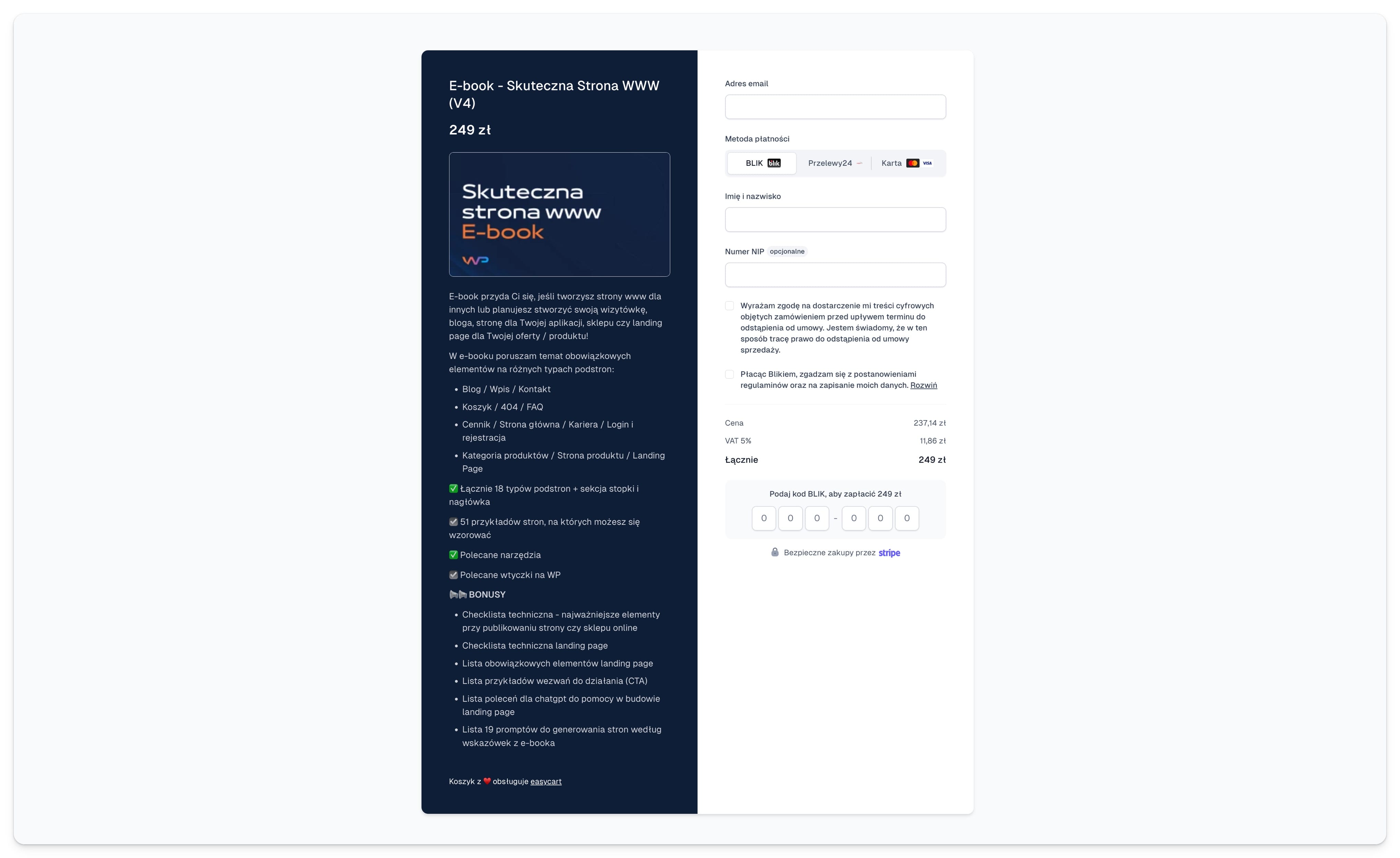Daniel Jeziorski: Why a WordPress specialist left WooCommerce
Daniel Jeziorski makes his living implementing WordPress for clients. But when it comes to selling his own services and products, he won't touch WooCommerce. Here's why.

At first glance, WooCommerce seems straightforward… then clients come to me for fixes – and they end up paying two or three times more than if they’d done it right the first time.
Daniel Jeziorski, a WordPress expert, built a successful service business, generating almost 70,000 USD in annual revenue. Instead of using the popular WooCommerce to sell his products and services, he opted for Easycart – a simpler, safer, and more suited solution that supports both service and digital product sales.
From agency to own business
A few years back, Daniel worked at a large SEO agency. His department was juggling hundreds of projects every month – the pace was relentless.
I loved working with WordPress, but I grew tired of agency life. Everyone in my department was handling hundreds of projects monthly. It felt like total chaos.
The turning point came when he spotted a competitor's ad offering ten times the rates for similar support. That’s when he decided to launch his own business.
He kicked things off with a blog, which eventually became his primary client acquisition channel. “I created an e-book as a lead magnet – it got tons of great feedback. Then I put it behind a paywall.” This was the beginning of his journey into digital products.
WooCommerce? "No, thanks."
Initially, Daniel tried selling through WooCommerce – a natural choice for a WordPress expert. But he quickly ran into frustrating issues.
For anyone in the WordPress world selling related services, WooCommerce seems like the go-to option. But I found it to be problematic in a lot of ways.
The biggest challenge that pushed him to switch to Easycart was subscriptions:
To create and sell subscriptions in WooCommerce, you have to buy another plugin, set up emails manually, and modify everything yourself. With Easycart, it just works and is ready to go.
Daniel also explored other SaaS solutions – including Zanfia (Mailinger) and SalesCRM – but none met his needs.
None of them were ideal for me, especially when it came to managing subscriptions. That’s why I chose Easycart.
Easycart: Just a few clicks
After switching to Easycart and Easytools, managing sales – both services and digital products – became much simpler.
This was crucial for me. Now everything really happens in just a few clicks.

Easycart allowed Daniel to:
- Easily sell e-books and courses
- Automate service subscriptions
- Integrate digital products with video access (Easyplayer)
- Reduce worries about personal data and site performance
- Focus on business rather than technical headaches
Despite working with WordPress daily, Daniel recommends Easytools to his clients who plan to sell digital products such as a course or e-book:
I usually recommend Easycart because it solves a lot of common problems. You won’t have to worry about personal data on the server, site speed, or technical optimization. WooCommerce can be a hassle – just a simple e-book can slow down the whole site if the implementation isn’t thought through.
Selling services via subscription
Most of Daniel's revenue comes from services – creating and maintaining websites, SEO care, and technical support. Some of these are offered as subscriptions.
I often provide SLA-type services in subscription – like website maintenance, minor fixes, hour packages, or ongoing support. This way, I can skip the formalities – I don’t worry about invoices or payments. And if someone cancels a subscription, I get a notification and know to stop the service.
The subscription model works great for SLA services, hour packages, and SEO consulting. But Daniel also uses Easycart in other business scenarios:
- Subscription-based installments – “Some of my clients need to pay for my services in installments, so I give them a cart link. I usually deliver the project within a month, and then I receive payments in installments over the next six months."
- Projects with individuals – “To streamline invoicing and the whole formal process, I have a sample cart ready for service execution with a dedicated service agreement."
Doing this in WooCommerce isn’t impossible, but it’s not as straightforward as in Easycart. Although some clients initially hesitate to enter their card details, the feedback is mostly positive.
Industry colleagues often say: 'Wow, this looks super professional,' and it’s not some complex agency CRM, just a regular cart.
WooCommerce issues are the norm
Daniel’s experience confirms this in his daily work – clients regularly come to him for help fixing failed WooCommerce implementations.
At first glance, WooCommerce seems simple… then clients come to me to fix everything – and they pay two or three times more than if they’d done it right the first time.
This isn’t a coincidence – it’s a systematic problem with a widely used but complicated tool.
70,000 USD in annual revenue
Daniel reached his ambitious goal in just his second year of operation:
One of my goals, in my second year, was to hit 70,000 USD in gross revenue. And I did it; in fact, I even exceeded it.
By leveraging the right tools and collaborating with a small, three-person team, Daniel can handle an impressive number of projects:
In six months, we completed 30 major projects and just as many smaller collaborations. Those are really impressive numbers.
Digital sales, like e-books, courses, and educational packages, make up a smaller portion of the business, but they play a really important supporting role.
Lessons from the path to success
1. Pre-selling saves time and money
Today, Daniel knows he must first gauge interest before spending countless hours creating a product.
If I were to create digital products now, I’d start with pre-selling. I once fell into the perfectionism trap – I kept creating a course forever, delaying monetization because I always felt it wasn’t ready. Some materials sat for a year before anyone saw them.
2. Delegating accelerates growth
It wasn’t until about two years in that I started delegating implementations. It really made a difference—freed up my time, and my revenue doubled.
3. Simple tools win over popular ones
Just because WooCommerce is popular doesn’t mean it’s the best solution. Sometimes, simpler tools work more effectively.
Future plans: More products, fewer hours
After the first intense years of running his own business, Daniel plans to shift to a model that focuses more on digital products:
I won’t hide it – those first two years, with a specific revenue goal, weren’t filled with 8-hour workdays, 5 days a week. I often worked significantly more, including weekends.
In the near future, Daniel aims to open courses more frequently, improve sales planning, and take more time off. He also sees a gap in the WordPress education market:
Even the biggest creators produce low-quality materials. I want to change that.
Summary
Daniel Jeziorski demonstrates that you can build a scalable, independent service business – without WooCommerce, without unnecessary complications, and without losing control over technology.
His story serves as a concrete lesson for anyone looking to monetize their knowledge by choosing tools that truly work and meet specific needs, rather than simply going for what’s popular.
Learn more about Daniel's work: https://tenodwordpressa.pl/
Follow Daniel's profile on LinkedIn: https://www.linkedin.com/in/tenodwordpressa/
Related articles
Ready for more? Check out these related articles that will keep your momentum going. They’re packed with easy-to-follow tips and tricks to help you supercharge your digital goods business.
Take it easy with Easytools
Focus on creating, and let Easytools handle the behind the scenes work.





